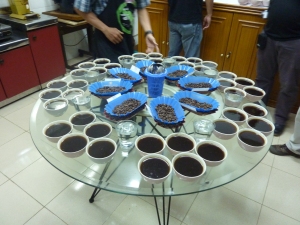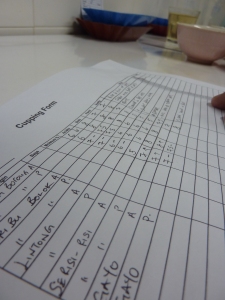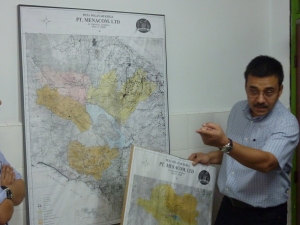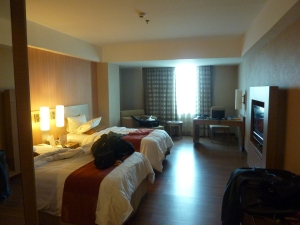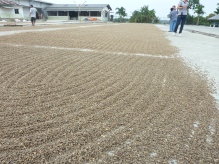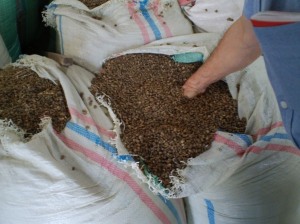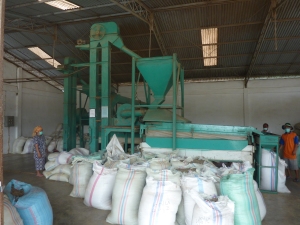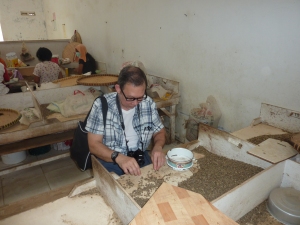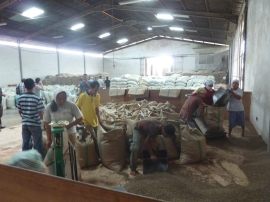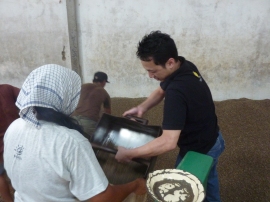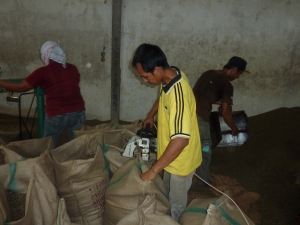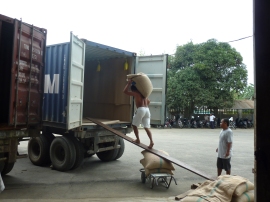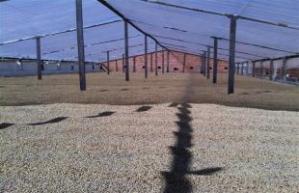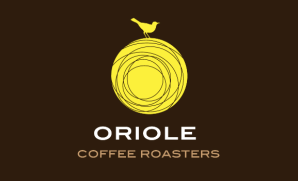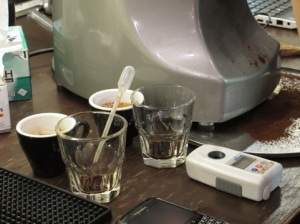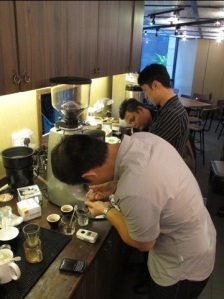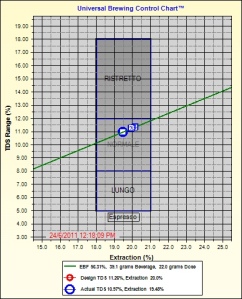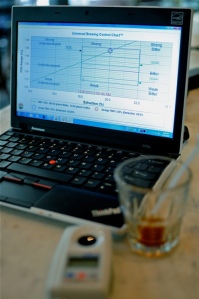Medan Trip Day 1 Part 2
-By John Ryan Ting
After a visit to the collection and coffee sorting centre, we made our way to PT Menacom’s Headquarters to visit their head office operations. Coffee had been prepared and was awaiting our arrival to cup them.
We were introduced to Pak Budi, PT Meanacom’s head of Quality Assurance. He had specially prepared a couple of lots of coffee from the collection of some of their smallholders’ lot. We were greeted by 10 lots of coffee that had been prepared for us, you can see 8 sets on the round table and another 2 prepared for us on the bench behind.
There were 5 different coffees from this round of cupping, each of them consisting of a batch that is sorted, and a batch that is ‘Asalan’ (refer to earlier blog on the explanation)
We were all given a cupping form to fill in what we tasted from the coffee; ‘asalan’ coffee from Siborongborong is rich & full of body, while the processed lots had clean distinct character of nuts in them. Coffee from Seribudolok had fruitier character with a nice rounded body while the processed lot was full of raspberries. The lots from Lintong was displaying notes of earthiness in both the lots, distinctively less body compared to all the other coffees on the cupping table.
The coffee from Serisi-risi was rich in body, beautiful notes of dried tobacco leaves and earthiness in the processed lot while the unprocessed lots had quite a few cups with defective flavours. The lot of coffee from Gayo was my personal favourite as it was more of the all-rounder with syrupy body in the ‘asalan’ lot and cleaner profile that reminds me of strawberries in the processed lot although it lost slightly a little body compared to the unsorted lots. (Do note that the lots from Gayo are actually from further north in the province of Aceh.)
After the first round of cupping, Pak Agam gave us a brief insight of the coffee that is coming out of Medan and shared with us the reason why most coffee coming out from the north of Sumatra is loosely named or labelled Mandheling. (notice the highlighted area on the map – this is mainly where smallholders that PT Menacom cooperates with, located within Medan.)
What was briefly communicated to us was that in olden days, the first inhabitants of Medan consisted of the people of Mandailing from the South Tapanuli Regency, along with Malays from the Malay Peninsula and the Karonese from the Karo Higlands.
Therefore Mandheling is actually named after the similarly spelled Mandailing people located in North Sumatra, Indonesia. The name is the result of a misunderstanding by the first foreign purchaser of the variety, and no coffee is actually produced in the “Mandailing region”.
And PT Menacom has more than 6000+ smallholders that have been working with them for quite some time to produce ‘Sumatra Mandheling’ coffee. They are loosely located around the highlighted area that you see on the map.
After that, we proceeded to the board room where they had prepared snacks for us while Karim gave us an insight into how the purchasing system in Sumatra, Indonesia works.
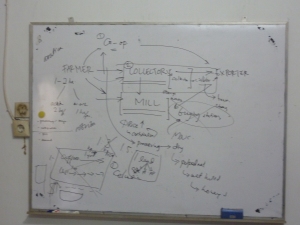 The coffee may either be purchased through a middle man who does the collection at the farms, after which, it may be sent to a milling station, or it may be sold through another middle man. (There may be many layers of collectors before the coffee gets to a milling station.) The final collector would then bring the coffee to the collection centre where they will begin to haggle on the price based on the finished product. (The guideline is for the coffee to be at 18% moisture content or less, if not the buyer would haggle & push the price down) Another option is some farmers forms a co-op, where they would gather the coffee at a single point, (normally a milling station) where they will sun-dry the coffee-in-parchment on patio before they send it for hulling. (More would be explained on the hulling process in the next blog post) Or in some cases, the exporter might work directly with the milling station to purchase the coffee and send trucks to collect the coffee at the milling station.
The coffee may either be purchased through a middle man who does the collection at the farms, after which, it may be sent to a milling station, or it may be sold through another middle man. (There may be many layers of collectors before the coffee gets to a milling station.) The final collector would then bring the coffee to the collection centre where they will begin to haggle on the price based on the finished product. (The guideline is for the coffee to be at 18% moisture content or less, if not the buyer would haggle & push the price down) Another option is some farmers forms a co-op, where they would gather the coffee at a single point, (normally a milling station) where they will sun-dry the coffee-in-parchment on patio before they send it for hulling. (More would be explained on the hulling process in the next blog post) Or in some cases, the exporter might work directly with the milling station to purchase the coffee and send trucks to collect the coffee at the milling station.
After all these, we were treated to some wonderful Indonesian dishes at a nearby restaurant for a late lunch before we proceeded to the hotel to rest our tired bodies.
We shall be updating our experience on the plantation real soon.
Medan Trip Day 1 Part 1
-By John Ryan Ting
It’s is 24 Jan 2012, Romeo Alfen and myself made our way to Singapore Changi Airport to meet up with the rest of the members of the Singapore Coffee Association that are making an origin visit to Medan, Indonesia.
Romeo, who is our Key Accounts Manager, is rewarded with this trip for his top-drawer performance in the recently concluded Singapore National Barista Championship. He bettered his results from previous years by coming in 1st runner up this year after putting in countless of hours of training leading up to the comp.
Our day begun at 0630hrs when we met up with the rest of the group at Starbucks Coffee after checking in at terminal 2, we have along this trip, Mel & Andre from Papa Palheta, Eric Huber & Zack from BonCafe, and of course, Mr Victor Mah, Ibrahim, and Karim who are the facilitators for this origin trip. After some light breakfast and some coffee before we boarded the plane for Medan.
After a flight time of 1 hour 10mins, we reached the airport of Polonia, Medan, where we were greeted by Agam Sulaiman, Managing Director of PT Menacom. (One of the leading producers & exporters of Arabica coffee in Indonesia)
Medan (Indonesian: Kota Medan; pronounced [meˈdan]) is the capital of the North Sumatra province in Indonesia. Located on the northern coast, Medan is the fourth largest city in Indonesia (behind Jakarta, Surabaya, and Bandung), and the largest Indonesian city outside Java. The city is bordered by the Deli Serdang Regency to the east, south and west, and the Strait of Malacca to the north. It is close to the volcano Sinabung, which erupted in August 2010 after a 400 year dormant state.
We travelled in 2 MPVs to their collection centre, where we were given a guided tour of their facilities. We were brought to their storage area of ‘Asalan’ coffee, which means ‘from the source’, coffee at this point have already been pulped, parchments have been removed, dried to a moisture level of 18% before being transported to collection centre in polymer bags and stored in a warehouse like the one you see in this picture before they go through the other processing stages.
their collection centre, where we were given a guided tour of their facilities. We were brought to their storage area of ‘Asalan’ coffee, which means ‘from the source’, coffee at this point have already been pulped, parchments have been removed, dried to a moisture level of 18% before being transported to collection centre in polymer bags and stored in a warehouse like the one you see in this picture before they go through the other processing stages.
During the harvest season, coffee collected will be stored in the warehouse and the coffee will be then be laid out on patio to be dried to a further moisture content of about 13%.
The drying process will vary over 1 to 2 days depending on the weather. The coffee will be raked every hour or so to promote even drying on all sides of the coffee.
After which, the coffee will be bagged into 100 kilogram bags and in turn will be sent to the gravity table to await their turn for sorting.
They will be sorted for their bean mass as well as bean size. Further to that, the coffee will be sent for another round of hand-sorting or more depending on any client’s specific order or instructions.
At the hand-sorting room, PT Menacom hires about 400 workers to go through the hand-sorting process of the coffee before they are sent to another room to be prepared for bagging and packing into containers for shipment of the coffee beans.
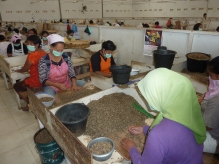
At the hand-sorting room, the ladies are given tubs & tubs of green coffee to be sorted. Each day, every one of them will be able to sort through 4kg of coffee that can be bagged for shipment. Certain times, the buyers would request for the coffee to be double-picked or triple-picked to ensure higher consistency and quality of the coffee.
Here you see Eric of BonCafe giving a hand at the sorting table, and trust me, we do know how tough this is.
After the coffee is sorted, they are all sent to the packing room, all the coffee are placed on a wooden platform, about 6 workers gather to pack the coffee into 69kg jute bags. Every 3 workers work at a single station to weigh & to pack them into the bags.
After that, the coffee will be sealed and prepared for shipment.
After bags of coffee have been sealed, they are being maunally carried and stocked in containers that are waiting to be shipped to the buyers. (noticed the interior of the containers, yellow pouches of dehumidifier and the whole container is lined with cardboard paper to shade the coffee from any heat transfer from the container to the coffee)
These basically summarize the function as well as the operations of this collection centre. The amount of work these guys and gals go to just to ship out containers of coffee for all of us to enjoy. I had a go at doing some the works these people go through, and within a few cycle, I was feeling the strain of the manual labour of bagging the coffee, and I decided to pass on the job to these experts. (You know what? That is not all that the processes is about, there is a huge part of the processing that happening even before this stage, and I eagerly awaits the visit to the plantations, milling, drying, hulling that is all due tomorrow. Guess I will be losing sleep tonight.)
We proceed for a cupping session at PT Menacom’s Headquarters after viewing this wonderful coffee collection centre.
Coffee Kids World Barista Champions 2012 Calendar
By Colin Loh
With the World Barista Championship spanning the last 12 years, Square Mile Coffee Roasters, and the last 12 World Barista Champions have come together to lend their hands and faces to a worthy cause – The Coffee Kids World Barista Champions 2012 Calendar.

Coffee Kids is a non-profit organisation which helps the poverty-stricken coffee-farming families improve their lives and livelihoods. Coffee Kids work with these families in 5 countries – Mexico, Guatemala, Peru, Honduras, and Nicaragua and their projects affect more than 81,000 people in more than 130 communities. Their projects fall into 5 categories:
- microcredit and economic diversification,
- health awareness,
- education and training,
- food security and
- capacity building
All proceeds from the sale of these calendars go towards Coffee Kids. For any additional donations, please proceed to the Coffee Kids website.
So, have a different handsome World Barista Champion in all his glory grace your wall above your espresso machine this year, for the next 12 months, and give yourself a pat on the back for championing this worthy cause. Coffee’s going to taste especially good with May’s Barista of the Month spread!
Unveiling the New Yellowbird Espresso Blend
By John Ryan Ting
It is once again time to introduce the latest changes to our flagship Yellowbird Seasonal Espresso Blend. We are proud to introduce the new bean that goes into our beloved blend that most of you have enjoyed over the last two years.
Recently, our Chief Geek Officer, Mr Keith Loh, made a trip to Brazil, the leading producer & exporter of Arabica coffee. He travelled with our esteemed coffee partners from Mercanta to the region of Bahia, located in the north-eastern part of Brazil. The main objective of this trip was to establish contact with some of the farms located in the Chapada Diamantina region as well as to evaluate the quality of the coffees coming out from this region, as compared to the much acclaimed Minas Gerais, Mogiana, Cerrado, Sul de Minas. The list goes on. (Keith will complete the blog about his trip.)
So today, I will be introducing one of the coffees that Keith has tasted and fallen in love with during his trip to Brazil. Fazenda Machado, located 1,240 metres above sea level, the farm extends over 100 hectares in the mountainous Chapada Diamantina region. Some 18 hectares are filled with a selection of Catuai, Acaua, Catucai, Topazio and Bourbon varieties.
Fazenda Machado is owned and managed by Sr. Agnon Aruajo of the Bahia region. As a young man, Aruajo decided to move to Sao Paulo to find work and earn a better living. However, after a few years he missed life on the farm so much that he moved back to Bahia and used all of his savings to buy Fazenda Machado, where he planted coffee and fruit trees.
This thoughtfully selected pulped-natural, mixed varietal coffee from Fazenda Machado is blended with our current selection of Ethiopia, Sidama. Our current Yellowbird Seasonal Blend exhibits notes of piped tobacco in the aroma, rich & intense mouthfeel, flavours of bright sweet prunes, with hints of umami in the mid palate, completed with lingering notes of pomelo in the finish.
Oriole Coffee & Technology Series – ExtractMojo
By Colin Loh
Termed by some as being “one of the best coffee universities around,” Oriole Coffee is no stranger to technology. Oriole Coffee never ceases to be on the forefront when it comes to leading the pack with high tech toys. Just recently, Oriole Coffee became the proud owner of the first La Marzocco Strada EP in Asia. This blog post marks the first of a series devoted to examining how Oriole Coffee integrates technology to help bring more bang to the consumer’s buck.
2010. Enter Vince Fedele and the ExtractMojo.
The ExtractMojo is a small hand-held refractometer which measures the coffee’s refractive index and determines its concentration, which can then be compared against an Universal Coffee Brewing Control Chart. You can read more about this technology on Gizmodo. Naturally, Oriole Coffee’s Chief Geek Officer, Keith Loh had to have it.
I spoke to Keith and he remarked excitedly, giddy as a schoolgirl that “now there was a tool to empirically assess the extraction levels of the way that I was pulling my shots and it probably allowed a consistent way to measure quantitatively instead of qualitatively what I was doing. I’ve attended many cupping classes and tasting classes and the one thing I realized is the diversity of opinions when it comes to taste and flavor. After understanding about brew strength and extraction yields, there was finally a tool that could actually produce these results on a repeatable and measurable basis easily through just one small device.”
Keith further elaborates that
“We’ve been using the Extract Mojo for almost 2 years and I feel it’s time to unveil that the Extract Mojo is the secret little weapon we have, or the secret little tool that has helped us to understand what we were doing. It comes full circle because we’re about to launch our VST baskets across all our outlets. In fact, we’ve actually been rolling out the VST baskets at all our outlets for almost a month now. And we’ve been backing up our results with the Extract Mojo as you can see here from our chart. The trickiest one and the one we left to the end was the Strada EP, of which we should be rolling out as we speak.
Keith adds “This is ultimately the means to an end, and not the means itself, the end being the entire product experience, and not just the coffee. When you sit down, how fast you get served, how it looks, how it’s presented, its price and how fast it’s being served to you – the product experience.”
This is the final grouping test we did for the Strada EP on the 22 gram basket. And as you can see, they’re so close that I don’t think we could’ve achieve such tight grouping with normal baskets. So, it’s nice to see that the Extract Mojo has proven that as we move along, we will continue to use technology to improve our consistency and let it work as a feedback loop to maintain our protocols, or to advance our protocols as we increase our volume.”
Last but not least, Oriole Coffee’s resident coffee roaster John Ting adds, “It changes how you looked at espresso extraction and makes you rethink all that you have learned, bringing you back to basics.”
Finca La Fany

unripe cherries waiting to mature
Some of you may have already noticed that we have a new coffee on the shelves. A coffee that gives you a juicy mouthfeel, notes of cane sugar, sweetness of oranges and honey, clean lingering finish.
Majority of El Salvador’s total coffee production is of the bourbon varietal, one of the most desired coffee varietals. It is harder to grow, more susceptible to disease and provides a lower yield than some other varietals, but it also produces some of the finest coffee in the world .This coffee is 100% Red Bourbon and is an example of one of El Salvador’s finest coffees. This shade grown coffee is exceptionally creamy and sweet. The cup leaves a mouth full of creamy caramel.

Baskets of Fully Ripe Cherries
Finca La Fany located in the altitudes of 1400- 1600 meters above sea level. Within the Department of Ahuachapán and in the municipality of Apaneca Ilamatepec Mountains region which translates to ‘River of Winds’; and this is by no coincidence! The winds in this region are very strong, so very tall Copalchi trees have been planted in a grid or waffle like shape to protect the coffee trees from strong winds.
Finca La Fany has been producing coffee in El Salvador since 1870, and has belonged to the same family from generation to generation. Situated on the Santa Ana Volcano, the farm provides work for 24 families in the community in a biological corridor that stretches for 28 hectares from Mexico to Panama and is full of Bourbon and Pacamara coffees.

Fantastic view of the farm
Rafael and his wife Carmen Da Silva have been running the farm for the last ten years, and are the fifth generation of their family to be producing coffee. Rafael is a keen agronomist and takes great care in looking after the farm.
Only just recently, the Da Silva’s installed a wet mill on their property which now gives them much greater control over the coffee from harvest through to export; a very exciting development.
Beautiful and delicate when brewed as a pour-over, sweet and creamy when enjoyed as an espresso.

